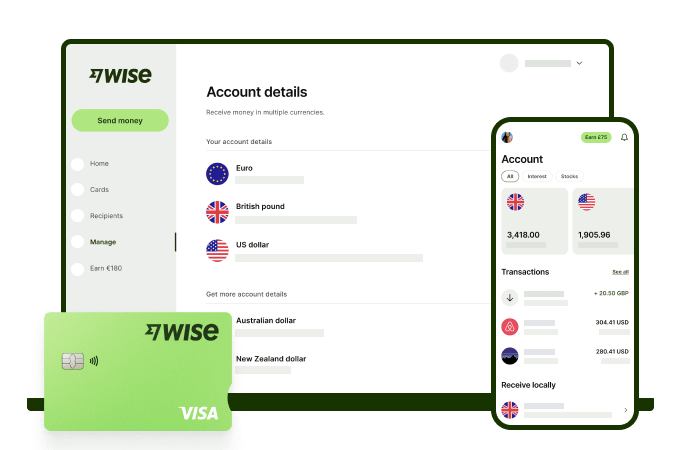
Moving to America: Step-by-step guide
The US is a top destination for Irish citizens looking to spend time overseas - either to study, work, retire, or emigrate for good. With a shared language and such a broad range of locations to choose from, it’s no wonder that spending time stateside is an attractive option.
This guide covers the basics you need to know when considering and preparing for a move to the USA.
We’ll look at the legal requirements, costs of living and how to get set up once you arrive - including a review of how Wise and the Wise multi-currency account can help you manage your money across borders.
Step 1: Check the legal requirements for Irish citizens moving to the US

The legal requirements for travel and immigration to any country can be complex, and tend to vary
significantly based on your situation. It’s essential to start researching early, to check what visa type you may be able to secure, to make sure you don’t run into legal barriers down the line.
Here’s an overview of the common options.
ESTA
As an Irish citizen, you can enter the US without a visa, but you’ll still need to apply for an ESTA (Electronic System for Travel Approval) approval before you head off. This gives you the right to stay in the US for up to 90 days. You’ll need a passport with at least 6 months validity to get this document in place.¹
An ESTA is a non-immigrant travel approval. It can’t be extended beyond the 90 days, or changed into another type of permit. ESTA may work for you if you’re thinking of a short trip to America or need to spend time scoping out more permanent options - but you’ll need to leave and reenter with the appropriate visa if you want to stay for longer.
US Visas
If you’re planning on staying for longer than 90 days in the US, you’ll need to investigate the visa options which may suit your needs. There are visas for employment, business, study, tourism and a range of other needs.
Visas are split according to their intended purpose and given letter designations to show which is which. For example, if you’re looking to make a transfer with your employer to the US you may need an L-type visa, while someone with a degree in a speciality occupation probably wants visa H-1B.²
Visas are typically split into immigration³ and non-immigration categories so you can choose the one which suits your situation. A good way to find the right visa for your requirements is to use the Visa Wizard on the US government website⁴. Enter your details and it’ll guide you through the options.
Green Card
A Green Card for the US is a permanent resident permission and lets you work and live in America without needing further visas and permits. Green Cards are subject to strict eligibility criteria based on your employment, or because applicants are related to a US citizen. Check out the full details, and assess your eligibility, on the US Citizenship and Immigration Services website.⁵
Step 2: Make sure you can afford to live in the US

The cost of life in the US will vary widely depending on where you choose to base yourself and the type of lifestyle you lead. The good news, though, is that there are a broad range of options to suit your preferences and budget.
Costs of rent and day to day life are higher in cities - as you’d expect, with a huge variance between different parts of the country. A good way to research cost of living in the US is to use an online comparison site like Numbeo. Users upload live data on prices, which you can then compare across different US cities and towns, and versus your current lifestyle in Ireland.
To get you started here’s a handy comparison of prices for some common items in the US v Ireland:
| Item | Cost in Ireland⁶ | Cost in the US⁷ |
|---|---|---|
| Meal at an inexpensive restaurant | €15 | €12.48 |
| 0.5 litres domestic beer | €5 | €4.16 |
| Loaf of bread | €1.48 | €2.26 |
| Monthly transportation pass | €110 | €55.75 |
| Rent one bedroom apartment in city centre | €1147.88 | €1,115.28 |
| Broadband package | €49.71 | €54.45 |
Step 3: Look for a job

Depending on your likely visa requirements, you might find you need a job before you travel to the US. There are a number of smart places to start looking, including online job websites like these:
It’s also worth researching which types of roles are currently in demand, and what the likely salary range is based on your expected location. You can find projections of in demand positions on the Bureau of Labour Statistics website⁸. At the time of writing, hot jobs featured included several in the healthcare sector, renewable energy roles, data scientists, IT professionals and information security analysts.
If you know what type of role you’ll be looking for, you can also get great salary data from Teleport. Salaries are shown for different locations in the US, as the pay you can earn will vary significantly. Here are a few examples for New York City, to give a point of reference:⁹
- Software engineers in New York City earn on average €78,833
- An NYC project manager could earn €69,109 on average
- The average salary for a nurse in New York is €62,415
Step 4: Find a place to live in the US

Finding a place to live is an important step in settling into life in the US. Good sites to start scoping out the options include online rental portals like these:
When you’re deciding where to live in the US it makes sense to look at the average costs of renting a place in a few locations to find the right balance of cost and lifestyle options. The most expensive states to rent in - on average - include Hawaii, California, Maryland and New Jersey. The cheapest states on the other hand are Kentucky, South Dakota, Arkansas and West Virginia.¹⁰
It’s good to note that the averages above are based on state data, not individual cities. The cost of living in a big city more or less anywhere in the world is likely to outstrip what you’ll pay for a more rural setup. Here’s the average rent for a one bed apartment in the city centre in 5 of the largest cities in the US:
| City | Rental cost |
|---|---|
| New York¹¹ | €2,640.53 |
| Los Angeles¹² | €1,896.07 |
| Chicago¹³ | €1,541.97 |
| Houston¹⁴ | €1,162.98 |
| Phoenix¹⁵ | €1,065.01 |
Step 5: Move your belongings

You’ll be able to move your belongings to the US by air or sea, with costs varying significantly depending on how much you choose to take with you, and where you’re headed. The length of time it takes for your goods to arrive will also be determined by the shipping method, with air freight taking only a week or so, sea freight with sole use of a container a little longer at 2-6 weeks depending on destination, and a shared sea freight shipment taking up to 14 weeks on average.
The good news is that you'll be able to get a few quotes for your move online before you decide, so you can assess the costs and decide what you want to take with you. Here are a few popular international shipping companies to start your research:
Step 6: Get your social security number
You’ll need to get a social security number (SSN) if you’re planning to work in the US.¹⁶
This number records all your employment and tax information and is a reference to make sure you’re paying the correct amounts of tax, and receiving the right benefits and deductions.
The way you apply for your SSN will depend on your visa situation. You may be able to apply before you travel to the US if you already have a job - or in person once you’re there. If you are in the US and choose to change your visa to allow you to work you might be able to get your SSN as part of your renewed visa application. If not, you’ll need to visit a social security office to get set up.
Step 7: Set up your finances in the US
You’ll have no problem finding a US bank account to suit your needs. However, it’s still worth researching and looking at a few different accounts before you apply, to make sure you’re getting the best one for your situation.
To open a bank account in the US, you’ll usually need your SSN (or ITIN - individual taxpayer identification number - if you have one), a photo ID, proof of residency, and an opening deposit. Most banks require you to attend a meeting in person to open your account.
One thing that’s worth thinking about is how you’ll handle your money across currencies when you’re dealing with dollars, but may still need to make or receive euro payments. Banks can charge high fees for international transactions, so it’s worth considering using a specialist provider for cross border payments, or getting a multi-currency account with USD bank details.
There’s also more on how Wiseand the multi-currency account can help you manage your money across borders, coming right up.
Step 8: Make sure to get health insurance

Free healthcare isn’t available in the US, so you must make sure you have adequate insurance coverage to deal with any medical emergency or eventuality.
Your health insurance options may depend on your immigration status, as well as your personal preferences. You’ll find you have different options if you have a Green Card¹⁷, for example, compared to a temporary work permit holder.
If you’re in the US with a working visa, you can choose a local health insurer or one of the large global companies offering policies. You may also find that your employer offers health care cover as part of your contract. Check through the terms of cover carefully to make sure you understand what is included.
Don’t expect the ways of working in the US health service to be similar to your experiences in Ireland. Standards of care are extremely high - but the system is very different. Research your cover and your options, to make sure you are comfortable in the case of health issues.
Move your money to and from the US with Wise

If you’re moving abroad it’s inevitable that you’ll need to send payments to and from your destination, and convert your money from one currency to the other.
Check out Wise for international payments which use the real exchange rate and just low, transparent fees. You can also get a Wise multi-currency account which makes it even easier to hold, send and spend over 50 different currencies.
Get paid in either euros or dollars - or a range of other currencies - into your multi-currency account, spend using your linked debit card, send payments all over the world, or withdraw to your regular account. It’s a simple way to make managing your finances easier, and saves money.
Sources:
- Travel.state.gov - visa waiver programme
- Travel.state.gov - employment
- Travel.state.gov - immigrate
- Travel.state.gov - visa wizard
- Uscis.gov - green card
- Cost of living in Ireland
- Cost of living in the United States
- Bls.gov - the fastest growing occupations
- Teleport.org - salaries in New York
- Worldpopulationreview.com - rent by state in the U.S.
- Cost of living in New York
- Cost of living in Los Angeles
- Cost of living in Chicago
- Cost of living in Huston
- Cost of living in Phoenix
- Ssa.gov - social security number for non-citizens
- Healthcare.gov
- Getcracking.ie
- MoveHub
- Irishmovers.ie
All sources last checked on February 17, 2021
*Please see terms of use and product availability for your region or visit Wise fees and pricing for the most up to date pricing and fee information.
This publication is provided for general information purposes and does not constitute legal, tax or other professional advice from Wise Payments Limited or its subsidiaries and its affiliates, and it is not intended as a substitute for obtaining advice from a financial advisor or any other professional.
We make no representations, warranties or guarantees, whether expressed or implied, that the content in the publication is accurate, complete or up to date.
